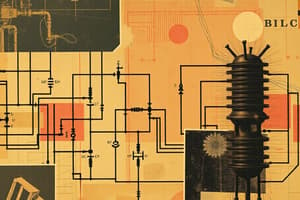Podcast
Questions and Answers
In a series circuit, what happens if there is a change in voltage?
In a series circuit, what happens if there is a change in voltage?
- All parts share the same amount of voltage. (correct)
- Each element receives different amounts of voltage.
- Voltage becomes zero.
- The current stops flowing.
Which type of circuit has branches where every branch receives its own supply independently?
Which type of circuit has branches where every branch receives its own supply independently?
- Series circuit
- Parallel circuit (correct)
- Hybrid circuit
- Mixed circuit
What does electric power refer to?
What does electric power refer to?
- The amount of charge stored in a battery
- The color of electrical wires
- The rate of work done by a force (correct)
- The resistance of a circuit
What kinds of components are usually found in electric circuits?
What kinds of components are usually found in electric circuits?
In a parallel circuit, how does each branch receive its supply?
In a parallel circuit, how does each branch receive its supply?
What happens if one element in a series circuit stops working?
What happens if one element in a series circuit stops working?
Which type of electrical circuit consists of elements connected end to end?
Which type of electrical circuit consists of elements connected end to end?
What is the function of a capacitor in an electric circuit?
What is the function of a capacitor in an electric circuit?
What is the role of diodes in an electric circuit?
What is the role of diodes in an electric circuit?
Which concept refers to the rate at which energy flows per unit time?
Which concept refers to the rate at which energy flows per unit time?
Flashcards
Series circuit voltage change?
Series circuit voltage change?
All parts share the same amount of voltage.
Circuit with independent branches?
Circuit with independent branches?
Parallel circuit
What is electric power?
What is electric power?
The rate of work done by a force.
Typical circuit components?
Typical circuit components?
Signup and view all the flashcards
Parallel circuit supply?
Parallel circuit supply?
Signup and view all the flashcards
Series circuit failure?
Series circuit failure?
Signup and view all the flashcards
Elements connected end to end?
Elements connected end to end?
Signup and view all the flashcards
Capacitor function?
Capacitor function?
Signup and view all the flashcards
Diodes role?
Diodes role?
Signup and view all the flashcards
Rate of energy flow?
Rate of energy flow?
Signup and view all the flashcards
Study Notes
In studying electric current physics for Class 11, students learn about various concepts related to electricity. One of these is the study of electric circuits, which involves understanding how the flow of electrons moves through components like resistors, wires, diodes, and capacitors. Understanding electric circuits helps you visualize the behavior of electronic systems such as batteries, bulbs, motors, and transformers.
Two common types of electrical circuits are series circuits and parallel circuits. A series circuit consists of two or more elements connected end to end, so all parts must share the same amount of voltage across them. This means that any changes in voltage will affect each part equally. On the other hand, a parallel circuit has branches where every branch receives its own supply independently of what other branches receive.
Another key concept is electric power. Power refers to the rate of work done by a force or the rate at which energy flows into it per unit time. For example, if a battery provides enough charge over a period of time, this is equivalent to the conversion of chemical potential energy stored in sulfuric acid into kinetic and thermal energies of hydrogen ions moving out of the electrolyte and producing current in the external circuit during discharge.
Finally, there is Ohm's Law, which states that the current flowing through a conductor between two points is directly proportional to the potential difference, or the electromotive force acting between those two points. It also specifies the relationship among resistance, current, and potential difference or voltage within a particular circuit.
Understanding these basic principles allows one to analyze different kinds of circuits and their properties effectively, helping both engineers and regular users of electronics understand the underlying mechanisms behind everyday devices.
Studying That Suits You
Use AI to generate personalized quizzes and flashcards to suit your learning preferences.




